| Share |  |
 | |||
Super Foods for Super Health & Fat-Burning
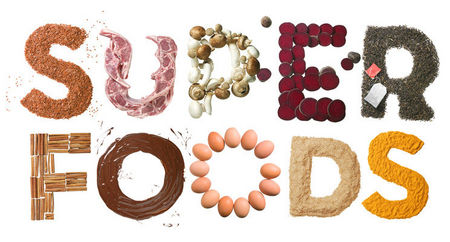 One of the secrets to a healthy body and a healthy weight is to consume foods that are as nutrient-dense as possible. The more you eat those types of foods while staying clear of the “empty-calorie” refined, processed, starchy or high sugar ones, the better off you will be.
One of the secrets to a healthy body and a healthy weight is to consume foods that are as nutrient-dense as possible. The more you eat those types of foods while staying clear of the “empty-calorie” refined, processed, starchy or high sugar ones, the better off you will be.
No exact criteria exist to identify whether a food (or spice or herb) warrants the classification “super food”. However, the term generally refers to a food that has an unusually dense concentration of vital nutrients (vitamins, minerals, antioxidants, good fats, fiber or other compound) and one that offers significant health benefits.
In addition to all the “good stuff”, a true super food will contain virtually no toxins, hormones, artificial ingredients, pesticides or chemicals of any kind. And it will not cause you to add pounds but instead should make it easier for you to lose any excess ones.
Even when you understand the nutritional benefits of a food, you may not necessarily care for that food; much less know how to regularly incorporate it into your diet. The good news is that the eight super foods I have chosen for this article can all easily be put together into one recipe: a “super” breakfast smoothie or meal replacement drink that is not only delicious and satisfying but also is “super” for your health and your waistline!
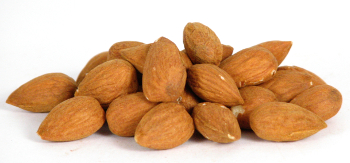 ALMONDS
ALMONDS
While all nuts provide a healthy source of protein and fat in addition to fiber and various vitamins and minerals, almonds offer the highest concentration of overall nutrients per calorie and per ounce. A one-ounce serving of almonds contains nearly 13 grams of unsaturated fat, 3.4 grams of fiber and 6 grams of protein (just one handful supplies approximately one-eighth of necessary daily protein). Almonds are also a good source of flavonoids and offers beneficial amounts of potassium, calcium, vitamin E, magnesium, phosphorous, biotin, folate, copper and iron.
Heart Health Benefits – The array of powerful flavonoids, vitamin E and monounsaturated fats in almonds are all associated with reduced risk of heart disease. The combined antioxidant action of the vitamin E along with the LDL-lowering effect of higher levels of monounsaturated fats accounts for this benefit. In human feeding trials, substituting almonds for more traditional fats resulted in an approximate 8 to 12 percent reduction of LDL cholesterol.
Almonds are also high in magnesium that helps veins and arteries relax. Less resistance of vessels improves the flow of blood, oxygen and nutrients throughout the body. The fact that almonds contain high amounts of potassium (162 mg.) is an additional plus for heart health since sufficient potassium levels are vital to maintain normal blood pressure and heart function.
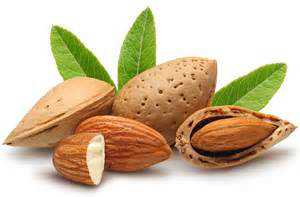 Benefits for Weight Loss and Blood Sugar Control - Since almonds are so packed with nutrients and particularly high in healthy fats and fiber, they are far more filling than eating grain-based “low-fat” snack foods. Feeling nourished and satisfied means you are less apt to be hungry and experience cravings. Plus slow digesting nuts provide a much more sustained type of energy than what you get from foods that quickly break down to sugar in the blood stream. As long as they are not overconsumed, snacking on almonds can reduce hunger without leading to weight gain (a general guideline for an appropriate amount of almonds per day is no more than what you can fit into your cupped palm). Research studies show that even when a high glycemic meal is eaten, adding almonds significantly slows down the digestion of the carbs and, therefore, lowers the glycemic index of the meal and the subsequent rise in blood sugar that occurs from eating it.
Benefits for Weight Loss and Blood Sugar Control - Since almonds are so packed with nutrients and particularly high in healthy fats and fiber, they are far more filling than eating grain-based “low-fat” snack foods. Feeling nourished and satisfied means you are less apt to be hungry and experience cravings. Plus slow digesting nuts provide a much more sustained type of energy than what you get from foods that quickly break down to sugar in the blood stream. As long as they are not overconsumed, snacking on almonds can reduce hunger without leading to weight gain (a general guideline for an appropriate amount of almonds per day is no more than what you can fit into your cupped palm). Research studies show that even when a high glycemic meal is eaten, adding almonds significantly slows down the digestion of the carbs and, therefore, lowers the glycemic index of the meal and the subsequent rise in blood sugar that occurs from eating it.
Guidelines for Almond Consumption
To obtain the optimum health benefits, only consume raw almonds and avoid those that are roasted with oil, honey or salt. Any almond butter you purchase should say “raw” and should contain no other ingredients other than salt. The valuable fats in nuts are damaged when they are heated and processed commercially.
Like all nuts, almonds contain compounds that inhibit the ability of our digestive system to break down and absorb the nutrients (particularly minerals). Soaking them 8-12 hours before eating (overnight works well) helps neutralize the enzyme inhibitors and increase the bioavailability of the nutrients (for more detailed information about how to soak and dehydrate nuts, I would refer you to the information in this article).
AVOCADO
Classified as a fruit, this creamy and delicious super food contains at least 20 essential nutrients and is associated with a number of health benefits. Avocados happen to be one of the safest fruits you can buy conventionally-grown and many experts indicate there is no need to purchase organic ones. Not only does their thick skin protect the inner flesh but avocados are also a crop with very limited pesticide exposure.
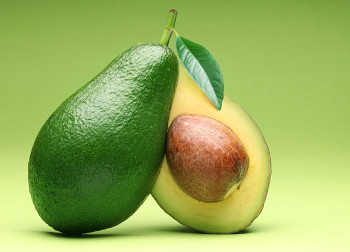 Although avocados are one of the fattiest plant foods, the bulk of the fat content consists of oleic acid, a monounsaturated fat that is easily burned for energy and is also associated with a number of health benefits. The net carbohydrate grams in avocados are relatively low since most of the carbohydrate content is from fiber (6-7 grams per half fruit).
Although avocados are one of the fattiest plant foods, the bulk of the fat content consists of oleic acid, a monounsaturated fat that is easily burned for energy and is also associated with a number of health benefits. The net carbohydrate grams in avocados are relatively low since most of the carbohydrate content is from fiber (6-7 grams per half fruit).
Avocados are especially rich in several of the B vitamins, vitamin K, vitamin E, potassium (higher than bananas!) folate, magnesium, phosphorous, iron and zinc. They are also high in carotenoids and antioxidants like beta-carotene, lycopene, lutein and zeaxanthin that protect cells from free radical damage and are particularly important for eye health.
Besides the fact that avocados are nutrient-rich, they also have been proven to help the body better digest nutrients from other foods. They especially aid in the absorption of fat-soluble nutrients such as vitamin A, D, E and K and improve the conversion of beta-carotene into active vitamin A.
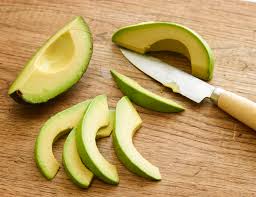 Heart Health Benefits - Avocados are high in a particular group of anti-inflammatory fats known as phytosterols. They contain 25 milligrams per ounce of beta-sitosterol, one such plant sterol that studies show reduces the risk of cardiovascular disease by improving blood lipid levels (cholesterol numbers) and lowering oxidative stress and inflammation. The high potassium content of avocados works to regulate the effects of salt, balancing the vitally important potassium/sodium ratio so necessary for maintaining healthy blood pressure levels.
Heart Health Benefits - Avocados are high in a particular group of anti-inflammatory fats known as phytosterols. They contain 25 milligrams per ounce of beta-sitosterol, one such plant sterol that studies show reduces the risk of cardiovascular disease by improving blood lipid levels (cholesterol numbers) and lowering oxidative stress and inflammation. The high potassium content of avocados works to regulate the effects of salt, balancing the vitally important potassium/sodium ratio so necessary for maintaining healthy blood pressure levels.
Weight Management Benefits - The amount of healthy fats in avocado helps reduce appetite by providing a sense of fullness. Studies conducted with overweight participants showed that replacing other foods with avocado or simply adding avocado to a meal lessened hunger and decreased the desire to snack or overeat. Most participants experienced weight loss as a result. The high fiber and low net carbs make-up of avocados is a further reason that this super food is a great choice for those wanting to maintain a healthy weight. The monounsaturated fat and soluble fiber content of avocados helps with both weight loss and health by keeping blood sugar levels steady and deterring the development of insulin resistance.
How to De-skin and Store an Avocado
Since the avocado’s highest concentration of anti-oxidants and carotenoids are located in the darker green outermost flesh, how you cut an avocado is important. Follow the “nick-and-peel” method below to preserve the areas that contain the greatest amounts of phytonutrients.
1. Cut the avocado length-wise to produce two long avocado halves that are still connected in the middle by the seed.
2. Holding each half, twist them in opposite directions until they naturally separate.
3. Remove the seed and cut each of the halves lengthwise to produce long quartered sections of the avocado.
4. Using your thumb and index finger, grip the edge of the skin on each quarter and simply peel it off just as you would a banana peel.
If you do not want to use the entire avocado, still follow steps 1 and 2. Allow the seed to remain in the half that you do not want to use, place the empty skin pieces of the other half over the exposed flesh (you can also sprinkle fresh lemon or lime juice to delay oxidation) and wrap the avocado in plastic wrap or place in a plastic storage bag. Store in the refrigerator and consume within a few days.
If they still feel hard, keep avocados at room temperature when you first purchase them. You will know that it is ripe when it yields to firm gentle pressure. Once ripened, use them immediately or store in the refrigerator so they will not become overripe.
BLUEBERRIES
Blueberries are among the most nutrient-dense berries. Like many berries, blueberries are low in calories (only 84 calories a cup) yet brimming with vitamins, minerals, anti-oxidants, fiber and many other beneficial phytonutrients. Blueberries are particularly high in vitamin C, vitamin K, potassium and manganese.
Blueberries’ greatest claim to fame is that they contain the highest antioxidant capacity of all commonly consumed fruits and vegetables. Anti-oxidants are essential to optimizing health by helping to combat and neutralize free radicals that can damage cellular structures as well as DNA.
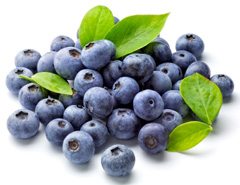 The four most powerful anti-oxidants in blueberries are anthocyanins, flavonols, tannins, and resveratrol (the same potent anti-oxidant found in red wine). It is the anthocyanins in blueberries that give them their deep blue/purple color and are responsible for much of their beneficial health effects.
The four most powerful anti-oxidants in blueberries are anthocyanins, flavonols, tannins, and resveratrol (the same potent anti-oxidant found in red wine). It is the anthocyanins in blueberries that give them their deep blue/purple color and are responsible for much of their beneficial health effects.
Weight and Blood Sugar Control Benefits – Along with most berries, blueberries are low on the glycemic index (GI) scale and high in fiber, two factors that are essential for managing weight and blood sugar. Even though the glycemic index of other berries like blackberries, strawberries and raspberries are somewhat lower than blueberries, studies show that the anthocyanins in blueberries have beneficial effects on insulin sensitivity and glucose metabolism. It is believed that certain types of anti-oxidants block activity of an enzyme that breaks starches into sugar, thereby lowering blood sugar levels and corresponding insulin release. In one study, obese participants with insulin resistance experienced improvements in insulin sensitivity by consuming a blueberry smoothie each day. Vitamin C in blueberries and other berries also stimulate the production of an amino acid (carnitine) that works to boost metabolism.
Heart Health Benefits - Due to the effects of its anti-oxidants, blueberries are strongly linked to reduced levels of oxidized LDL. In an eight-week study in which obese individuals at high risk for heart disease were given a daily 50 gram serving of blueberries, results showed a 27 percent lowered LDL oxidation and a 4-6 percent reduction in blood pressure. Blueberries are naturally free of sodium and contain potassium, calcium, and magnesium, all of which help to decrease blood pressure naturally.
Brain Health Benefits – Research conducted in both animals and humans have confirmed that anti-oxidants in blueberries help aging neurons and lead to improvements in cell signaling that make communication between neurons more effective. Better communication across brain cells helps with alertness, memory, and cognitive function and also delays age-associated mental decline.
Guidelines for Using and Storing Blueberries
In order to take the fullest advantage of the great nutritional benefits of blueberries, it is best to eat them fresh or use them in smoothies rather than in baked desserts, pancakes, jams, etc. Even though blueberries cannot be obtained fresh year-round, the good news is that they freeze well and retain most of their overall nutrient levels and antioxidant capacity as well as concentrations of anthocyanins.
If you are able to obtain organic blueberries, they do have significantly higher concentrations of total antioxidants and anthocyanin antioxidants than conventionally grown blueberries, as well as significantly higher total antioxidant capacity.
CHIA SEEDS
The tiny black seeds of the chia plant first were grown and used in Central and South America. At one time, they were a major dietary component of the ancient Aztec and Mayan cultures. In fact, the name “chia” is the ancient Mayan word for “strength”. Known to provide sustainable energy, these seeds were used as survival rations for the Aztec warriors.
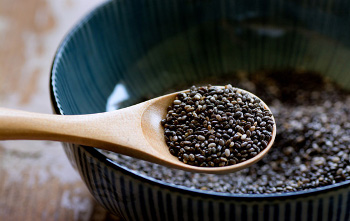 Chia seeds are loaded with a number of nutrients that support health, boost energy and even help regulate weight. Here are some facts you may not know about the make-up of chia seeds and their special benefits:
Chia seeds are loaded with a number of nutrients that support health, boost energy and even help regulate weight. Here are some facts you may not know about the make-up of chia seeds and their special benefits:
Nutritional Benefits
Good Source of Fiber - chia seeds are 40 percent fiber by weight. Two tablespoons of chia seeds provide 10 grams of fiber, close to a third of the daily recommended intake of fiber per day. The fiber absorbs large amounts of water and expands in the stomach, increasing fullness and slowing the absorption of food. Fiber also feeds the friendly bacteria in the intestine, which is important for health and weight loss.
High in protein – chia seeds contain 14 percent protein, which is fairly high for a plant protein source.
Rich in essential fatty acids - 60 percent of the fats in chia seeds are comprised of an essential fatty acid (alpha-linoleic acid or ALA) which the body can use to make EPA and DHA, the components of anti-inflammatory omega-3 fatty acids associated with numerous health benefits.
High in anti-oxidants – antioxidants help protect the body from free radicals, aging and cancer. Due to their high antioxidant content, chia seeds do not easily deteriorate and can be stored for long periods of time without becoming rancid.
Mineral rich - just two tablespoons of chia seeds contain 18 percent of daily recommended amounts for calcium, 35 percent for phosphorus, 24 percent for magnesium and about 50 percent for manganese. Other minerals that are abundant in chia seeds include copper, iron, phosphorus and zinc. These minerals are important for energy metabolism, DNA synthesis, preventing hypertension and maintaining a healthy weight, strong bones and balanced nervous system.
Low carb content – chia seeds are only one gram per ounce of carbohydrates and most of the carbohydrate content consists of fiber.
Health and Weight Loss Benefits
Promote satiety – the protein and fiber content of chia seeds, along with their gelling action that slows digestion makes them helpful for appetite control and weight loss (chia seeds absorb up to 27 times their weight when added to liquids). A greater sense of fullness cuts down on snacking and the tendency to overeat.
Promotes energy and blood sugar control - The fact that chia seeds digest slowly helps provide long-lasting consistent energy rather than the slumps in energy that often occur when blood sugar levels spike too high. This benefit of chia seeds can play an important role in regulating insulin levels.
Guidelines for Using Chia Seeds
Chia seeds can be soaked in liquid and added to porridge, made into pudding, used in baked goods, smoothies or simply sprinkled on top of salads or yogurt. Although chia seeds do not have to be ground prior to consuming, pre-soaking them in liquid prior to adding them to smoothies or foods can increase their digestibility and make nutrients more absorbable.
Due to the gel forming ability of chia seeds, they can also be used to thicken sauces or as an egg replacement in recipes (simply mix 1 tablespoon of chia seeds with 3 tablespoons of water and let sit for 15 minutes). According to a study published in the “Journal of the Academy of Nutrition and Dietetics”, you can replace 25 percent of the oil or egg in a cake recipe with chia gel without impacting taste or texture.
CINNAMON
Cinnamon is a highly delicious nutrient-rich spice loaded with powerful antioxidants to protect cells against free-radical damage that accelerates aging and degenerative conditions. Cinnamon is high in polyphenols and bioflavonoid anti-oxidants as well as calcium, fiber, iron and manganese.
Just one teaspoon of cinnamon is equal to the same antioxidant potency as a half cup of blueberries. In a study comparing the antioxidant activity of 26 spices, cinnamon came out the clear winner, beating powerful herbs and spices such as garlic, thyme, rosemary, and oregano.
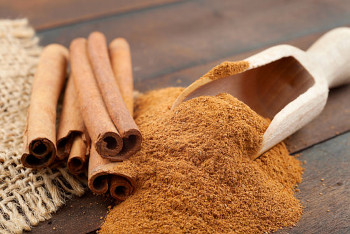 The distinct smell and flavor of cinnamon is due to the oily part that is very high in cinnamaldehyde, a compound responsible for most of cinnamon’s powerful effects on health and metabolism. As little as a half teaspoon of cinnamon daily can positively impact blood sugar levels, heart health, digestion, immunity, and even neuro-degenerative diseases.
The distinct smell and flavor of cinnamon is due to the oily part that is very high in cinnamaldehyde, a compound responsible for most of cinnamon’s powerful effects on health and metabolism. As little as a half teaspoon of cinnamon daily can positively impact blood sugar levels, heart health, digestion, immunity, and even neuro-degenerative diseases.
Heart Health Benefits - Studies have shown that the anti-oxidant and flavanoid compounds in cinnamon work to reduce several of the most common risk factors for heart disease, including high cholesterol levels, high triglyceride levels, and high blood pressure. Compounds in cinnamon help to fight dangerous inflammation and reduce the oxidative stress responsible for damage to arteries and the subsequent build-up of plaque. Cinnamon is also well researched for its ability to prevent unwanted clumping of blood platelets and help increase blood circulation. This tasty spice has even been shown to reduce levels of blood fats that occur after high-fat meals as well as limit nitric oxide build up in the blood.
Weight Loss Benefits - Cinnamon contributes to weight loss and better blood sugar control in a number of ways. Because it takes a little extra energy to metabolize, cinnamon speeds up metabolism to increase fat and calorie burning. It also helps to suppress appetite and produce a greater sense of fullness by slowing down the breakdown of carbohydrates and the passing of food from the stomach into the intestine. Plus its natural sweetness can help alleviate cravings for sugary foods, reducing the temptation to reach for high calorie desserts.
Blood Sugar Control Benefits - Cinnamon helps regulate blood sugar levels by imitating the activity of insulin, which significantly increases the sensitivity of cells to its blood sugar lowering effects. By helping insulin do its job, more glucose is absorbed and less is converted to fat (a weight loss benefit as well). In studies, cinnamon was found to increase glucose metabolism by about 20 times and lower the glycemic index of a meal by 18-29 percent. One 12-week study of diabetics who took 2 grams of cinnamon daily showed an average 8.22 percent drop in A1c levels as well as significant reductions in blood pressure.
Uses and Tips for Cinnamon
It is best to purchase cinnamon in smaller quantities since it can become stale quickly, losing both flavor and aroma. Since foods that undergo radiation in their processing may form free radicals, look for organic cinnamon that is not irradiated.
Cinnamon should be stored in a cool, dark and dry place. Ground cinnamon keeps for around six months whereas cinnamon sticks can maintain freshness for about a year. To check for freshness, smell your cinnamon. If the aroma is no longer sweet, replace it with fresher cinnamon.
Cinnamon can be freely used in many different types of foods and cooking as well as in smoothies, hot beverages (teas, cider, hot chocolate, etc.), on hot cereal, fruit, vegetables (like sweet potatoes and squash) and in muffins, pancakes, granola bars, meat rubs, chili, or mixed in almond butter with a little vanilla for a healthy low glycemic dip for apples. The possibilities are endless when it comes to cinnamon.
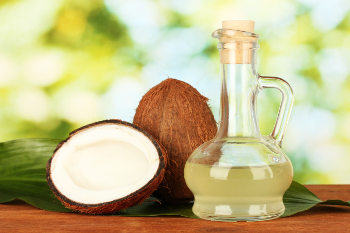 COCONUT OIL
COCONUT OIL
Out of all dietary fat sources, coconut oil is the most readily absorbed and efficiently utilized for quick energy. Unlike polyunsaturated vegetable oils that are chemically reactive and sensitive to heat, coconut oil is a stable oil that consists of 90 percent saturated fat. It does not oxidize (turn rancid and form free radicals and other harmful compounds) easily and is, therefore, much safer for higher heat cooking.
Coconut oil offers a multitude of health benefits that include boosting energy, supporting heart health and thyroid function, weight loss, improved digestion, blood sugar regulation and immunity against a host of infections.
Energy Benefits - Rather than contribute to fat stores, the medium-chain fatty acids in coconut oil (MCT’s) are rapidly broken down by the liver and converted to a type of fat the body uses for energy. One study found that 15-30 grams of MCT’s per day increased the amount of energy expended by five percent, totaling about 120 calories per day.
Heart Health Benefits – Unlike manufactured hydrogenated saturated fats (i.e. trans fats) that have given saturated fats a bad reputation, coconut oil actually promotes heart health. Cardiovascular disease rates in Pacific Island populations that heavily consume coconut oil are nearly non-existent. Studies indicate that healthy saturated fats like coconut oil help to reduce cholesterol, triglyceride and LDL cholesterol levels while boosting levels of the more desirable HDL.
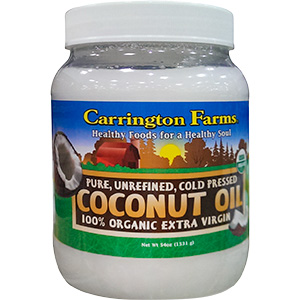 Weight Loss Benefit – Medium chain fatty acids found in coconut oil promote satiety, boost metabolism, stimulate thyroid function, and reduces abdominal fat (the health damaging fat that lodges around organs in the abdominal cavity).
Weight Loss Benefit – Medium chain fatty acids found in coconut oil promote satiety, boost metabolism, stimulate thyroid function, and reduces abdominal fat (the health damaging fat that lodges around organs in the abdominal cavity).
Immune Benefits – Lauric acid that makes up about half the fatty acids in coconut oil is converted by the body into monolaurin, a substance reported to inactivate many viruses, bacteria, protozoa and fungi. This compound disrupts the lipid structure of these microorganisms without negatively affecting beneficial gut bacteria.
Brain Health Benefits - Ketone bodies produced in the liver from medium chain fatty acids found in abundance in coconut oil provide an alternative fuel for degenerating brain cells. Research and evidence exists that Alzheimer’s and other brain disorders may be due to atrophy of brain cells from insulin resistance of the brain. When this occurs, brain cells lose the ability to turn glucose into energy and begin to starve as a result. Evidence suggests that ketone bodies may actually help restore and renew neurons and nerve function in the brain, offering profound benefits in the fight against Alzheimer's disease as well as other neurodegenerative disorder such as Parkinson’s and Lou Gehrig’s (ALS).
Guidelines for Buying and Using Coconut Oil
If possible, avoid buying coconut oil that is refined or that says “hydrogenated” or “partially hydrogenated” on the label. Although refined coconut oil does have a higher smoke point, the extra processes it goes through usually takes out much of the flavor. If you do buy a refined version, make sure that the refining process method used to extract the oil was chemical-free (examples - friction, heat or spinning/gravity). Unrefined or “raw” coconut oil is made from fresh, raw, coconut meat with no added chemicals and high-heat is not used to further refine the oil.
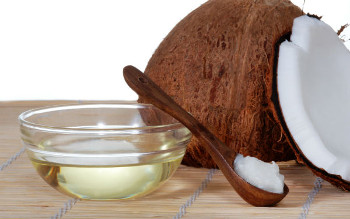 The advantages of “cold-pressed” coconut oil are that it is considered “raw” and retains all of its nutrients. It has a strong coconut flavor and tiny traces of the soluble parts extracted from the dried coconut meat. “Expeller-pressed” is mechanically extracted without the use of solvents or chemical processed. It has less coconut taste than “cold-pressed” or “raw” and also has a higher smoke point which makes it a better oil for higher heat cooking.
The advantages of “cold-pressed” coconut oil are that it is considered “raw” and retains all of its nutrients. It has a strong coconut flavor and tiny traces of the soluble parts extracted from the dried coconut meat. “Expeller-pressed” is mechanically extracted without the use of solvents or chemical processed. It has less coconut taste than “cold-pressed” or “raw” and also has a higher smoke point which makes it a better oil for higher heat cooking.
When it comes to “virgin” or “extra virgin”, there is no significant difference with regard to coconut oil. The label “organic” simply means that the coconuts used for the oil were grown without the use of pesticides which is the better choice if you are able to obtain that kind.
Coconut oil can be stored at room temperature as long as it is not in direct sunlight. Due to its stability, it can last as long as two years without going bad. When the room temperature is below 75°, coconut oil will be a solid fat that looks white, thick, and creamy. In its liquid state, it is clear and easy to pour. If you need coconut oil in a liquid state for a recipe or smoothie drink, it melts very quickly when placed in a toaster oven or saucepan on the stove but be careful not to overheat it. You can solidify it if it is in the liquid form by simply placing it in the refrigerator.
Be careful not to cook coconut oil beyond its smoke point as it will begin to deteriorate and turn yellow. If this occurs, the oil should not be used.
FLAXSEEDS
Flaxseeds are a true super food that provides an array of important health and weight management benefits. These nutrient-rich nutty tasting seeds are primarily known for their high content of alpha linoleic acid (ALA, an omega-3 fatty acid), fiber and lignans. In addition to these important nutritional components, flaxseeds contain all nine essential amino acids as well as significant amounts of vitamin B1, manganese, magnesium, phosphorus, selenium, iron, potassium, copper and zinc.
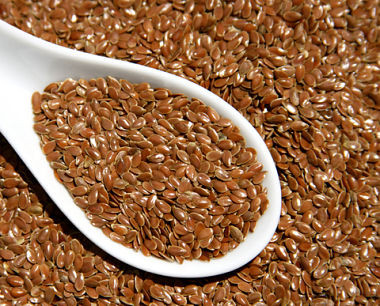 Omega-3 Fatty Acids – Flaxseeds contain approximately 40 percent oil and are the number one dietary source of alpha linoleic acid (commonly referred to as ALA), the precursor to the EPA and DHA components of omega-3. Omega-3 fatty acids are noted for their anti-inflammatory benefits and are vital for supporting the health of the heart, circulatory system, brain, eyes and many other systems and functions in the body. In addition, eating more healthy fats (along with the fiber flaxseeds provide) helps with weight loss by contributing to a sense of fullness and satisfaction that prevents overeating. Anti-inflammatory benefits from the fatty acids in flaxseed also help to reduce weight-related inflammation.
Omega-3 Fatty Acids – Flaxseeds contain approximately 40 percent oil and are the number one dietary source of alpha linoleic acid (commonly referred to as ALA), the precursor to the EPA and DHA components of omega-3. Omega-3 fatty acids are noted for their anti-inflammatory benefits and are vital for supporting the health of the heart, circulatory system, brain, eyes and many other systems and functions in the body. In addition, eating more healthy fats (along with the fiber flaxseeds provide) helps with weight loss by contributing to a sense of fullness and satisfaction that prevents overeating. Anti-inflammatory benefits from the fatty acids in flaxseed also help to reduce weight-related inflammation.
Note: ALA alone cannot provide sufficient conversion to EPA and particularly DHA to exclude the need for animal-based omega-3 sources such as wild-caught fish and fish oil supplements.
Fiber - Flaxseeds are a great source of both kinds of fiber (soluble and insoluble) with just two tablespoons providing nearly six grams. Soluble fiber in flaxseed slows carbohydrate absorption which helps stabilize blood sugar levels. It also helps to improve cholesterol levels by binding with cholesterol and bile acids and eliminating them from the body. Since bile acids are made from cholesterol stored in the blood, levels are reduced because more cholesterol gets used up to replenish them.
Insoluble fibers in flaxseeds act as a scrub brush for the intestines and assist in the removal of toxins, excess hormones and other wastes from the body. This type of fiber also works to ease elimination and improve regularity by absorbing water in the intestinal tract in addition to providing food for friendly bacteria in the colon.
Lignans – Lignans are unique fiber-related polyphenols that provide antioxidant benefits for cellular health and anti-aging in addition to improving hormone balance by acting as plant estrogens. Lignans also support the growth of probiotics in the gut and possess anti-viral and antibacterial properties.
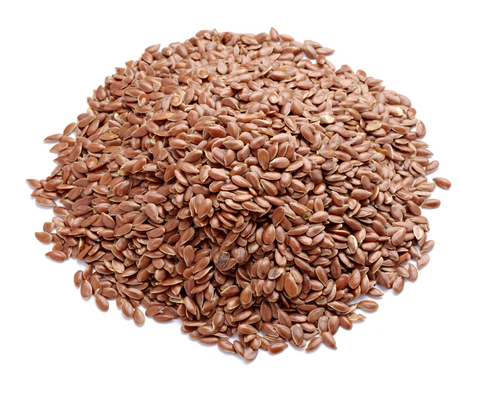 When flaxseeds are eaten, bacteria in the digestive tract convert lignan precursors into two estrogen-like chemical compounds (enterodiol and enterolactone) that work to prevent and reverse hormone-associated cancers such as breast, uterine or prostate. They do so by binding to estrogen receptors and blocking the effect of excess harmful estrogens. Flaxseeds contain 800 times as many of these lignan compounds as any other plant - seven times as many as sesame seeds, the closest runner up.
When flaxseeds are eaten, bacteria in the digestive tract convert lignan precursors into two estrogen-like chemical compounds (enterodiol and enterolactone) that work to prevent and reverse hormone-associated cancers such as breast, uterine or prostate. They do so by binding to estrogen receptors and blocking the effect of excess harmful estrogens. Flaxseeds contain 800 times as many of these lignan compounds as any other plant - seven times as many as sesame seeds, the closest runner up.
Guidelines for Using and Storing Flaxseeds
Flaxseeds need to be lightly ground to remove their hard hulls before eating or they will pass through the body undigested. A coffee bean grinder, spice grinder or small food processor works well to “free” the nutrients from flaxseeds in order to ensure optimal absorption.
Because flaxseeds are high in beneficial omega 3 fats, they can oxidize (go rancid) quickly since their chemical structure renders them extremely sensitive to heat, light and oxygen. Therefore, it is best to grind flaxseeds as you need them rather than purchase pre-ground flax meal. This is recommended because you have no idea how long ago the purchased bag was ground or the degree to which the ground flax was exposed to any of the factors that cause a breakdown in these delicate fats.
To help retain the nutritional properties of your flaxseed, store it (whole or ground) in an airtight container in the fridge or freezer. Use dark or opaque containers and be sure not to use anything with metals as they may contain minerals could break down the good fats.
Ground flax seeds can be added to smoothies, yogurt, mashed fruit, hummus or nut butters or you can sprinkle them on salads, hot breakfast cereals, cooked vegetables or sandwiches (combine the flaxseed meal with mayonnaise, mustard or other sandwich spread).
KALE
While all dark leafy greens are super foods, calorie for calorie kale tops the list for nutrient density. Just 50 calories worth of kale provides 3.3 grams of protein and 2 grams of fiber. This king of the vegetable world is also loaded with vitamins, minerals, fiber, antioxidants and many other health-promoting compounds and phytonutrients.
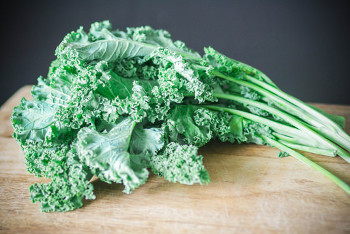 A 100 gram portion of kale contains twice the recommended daily amount for Vitamin C – double that in an orange with far less sugar grams. Kale contains 10 times the RDA of vitamin K1 that plays a vital role in bone health, regulating blood sugar levels and preventing calcification of the arteries. In addition, it is high in several B vitamins (B-6 in particular), potassium, calcium (contains more gram per gram than cow’s milk), magnesium, copper and manganese. Kale is often referred to as the “new beef” due to the fact that it contains close to the same amount of milligrams as iron per 100 grams as beef.
A 100 gram portion of kale contains twice the recommended daily amount for Vitamin C – double that in an orange with far less sugar grams. Kale contains 10 times the RDA of vitamin K1 that plays a vital role in bone health, regulating blood sugar levels and preventing calcification of the arteries. In addition, it is high in several B vitamins (B-6 in particular), potassium, calcium (contains more gram per gram than cow’s milk), magnesium, copper and manganese. Kale is often referred to as the “new beef” due to the fact that it contains close to the same amount of milligrams as iron per 100 grams as beef.
Kale is extremely high in beta-carotene (an antioxidant that the body converts to Vitamin A). A 100 gram portion of kale provides 300 percent of the RDA for this important vitamin.
In addition to beta-carotene, kale is particularly rich in other important carotenoids such as lutein and zeaxathin that protect eyes from developing macro degeneration or from damaging UV rays that can result in cataracts. Other anti-oxidants abundant in kale are quercetin and kaempferol that help protect heart health in addition to combating inflammation, viruses and cancer.
Weight Loss Benefits - Kale is a perfect weight loss superfood. Even though it is low in calories, its nutrient richness works to help a person feel full and satisfied. Protein and fiber, two other valuable nutrients for weight loss, are also found in kale along with omega-3 and omega-6 essential fatty acids.
Heart Health Benefits - Kale helps with cholesterol levels due to the presence of substances that bind bile acids in the digestive system and prevent them from being reabsorbed. One study found that daily consumption of kale juice for 12 weeks increased HDL (the “good”) cholesterol by 27% and lowered LDL levels by 10%
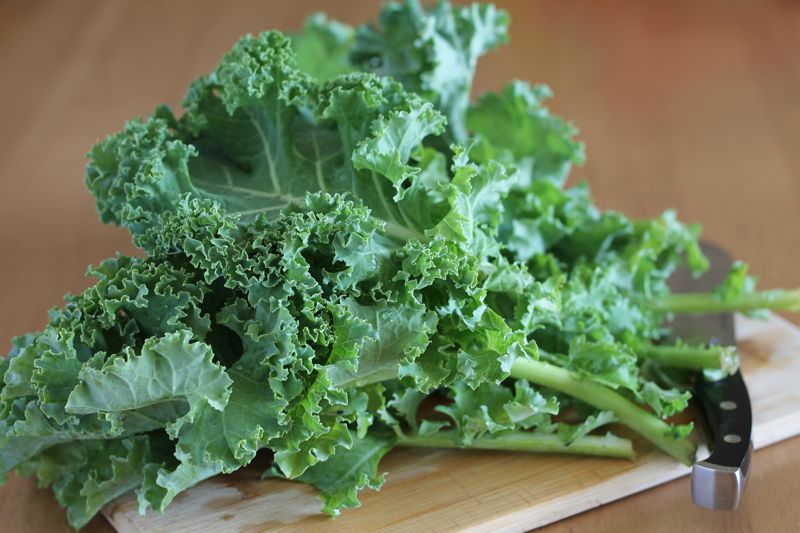 Cancer Fighting Properties – Like most cruciferous vegetables, kale contains sulforaphane, a substance that has been shown to help fight the formation of cancer at the molecular level. In addition, it supplies a substance known as indole-3-carbinol that works to both prevent and slow the growth of cancer cells and assist in DNA cell repair.
Cancer Fighting Properties – Like most cruciferous vegetables, kale contains sulforaphane, a substance that has been shown to help fight the formation of cancer at the molecular level. In addition, it supplies a substance known as indole-3-carbinol that works to both prevent and slow the growth of cancer cells and assist in DNA cell repair.
Guidelines for Using and Storing Kale
Because kale tends to get more bitter the longer it is left at room temperature, keep it stored in the coldest part of your refrigerator. Do not wash kale prior to storing as it will only increase spoilage. Rather, wrap fresh kale in damp paper towels and place in an air-tight bag. Kale is sensitive to ethylene that is formed naturally from certain other produce (apples, apricots, avocados, melons, nectarines, peaches, pear, plums and tomatoes) so store it away from those produce items if possible. Although it can stay fresh up to a week if properly stored, it is best to use kale within a few days as its bitter flavor component grows stronger the longer it is stored.
Kale can be used in alone as a vegetable side or in smoothies, salads, stir-fries, soups and stews. When cooking kale, keep in mind that one pound of raw kale yields only about a half cup of cooked. Need ideas for recipes that use kale? Kale is so popular now that searching “kale recipes” online will provide you with countless ideas for delicious ways to use this power-packed vegetable!
Kale Caution: People with low thyroid function should limit their consumption of raw kale. Kale is part of the cruciferous family of vegetables that produce certain compounds that can suppress thyroid function by blocking the body’s ability to uptake iodine (iodine is especially needed by the thyroid as it contains the highest concentration in the body). Excessive consumption of raw cruciferous vegetables (in excess of two cups per day) is not recommended and could especially be a problem for those with existing low thyroid function. Steaming these types of vegetables until they are fully cooked removes at least a third of these compounds while boiling for 30 minutes destroys 90 percent of them. Cooking kale and freezing it in ice cube trays provides a way to still use kale in smoothie recipes. Adding rich iodine sources such as seaweed, kelp, wild caught fish, Brazil nuts, etc. is also a way to offset the effects of these goitrogenic compounds.
Boost Your Super Food Intake
Super foods are by no means a quick fix or miracle workers on their own but can produce many added benefits when used in conjunction with an overall healthy diet. While you may not be in the habit of using some of the food items I selected for this article on a regular basis, I would encourage you to begin to take steps to branch out and try some new things to boost your health and shed any undesired pounds.
One way you can do this is by starting your day with a breakfast smoothie made using some or even all of these ingredients. You actually do not need an exact recipe to make smoothies with healthful ingredients. Use this one as a guide to give you the general idea and then make your own adjustments based on what ingredients you have on hand and your taste preferences. While this recipe does not call for a protein powder, a scoop of protein powder can be used to increase the protein grams if desired.
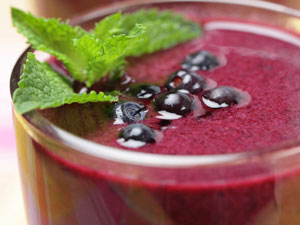 SUPER FOOD SMOOTHIE
SUPER FOOD SMOOTHIE
Ingredients:
¾ cup frozen berries (blueberries, raspberries, or strawberries or a combination of two or all of them)*
8 ounces almond or coconut milk (unsweetened preferably)
¼ cup raw pre-soaked almonds (without skins is preferable – skin comes off easily after almonds are soaked)
2 tablespoons raw almond butter
1 handful of raw kale or 1 frozen cooked kale cube (remove stems from raw kale)
¼ avocado
2 teaspoons chia seeds pre-soaked in ¼ cup water (can soak overnight or as little as 30 minutes ahead)
2 teaspoons ground flaxseeds (golden flaxseeds are the better option for smoothies as they are lighter in color)
1-2 tablespoons melted coconut oil
¼ teaspoon ground cinnamon (optional)
½ teaspoon vanilla (optional)
Sweetener of choice (optional – if you do not use a protein powder blend that contains a sweetener, you can add a few drops of stevia for better taste. If you do not have blood sugar or weight issues, you can add a couple of dates or ¼ of a banana to give it more sweetness)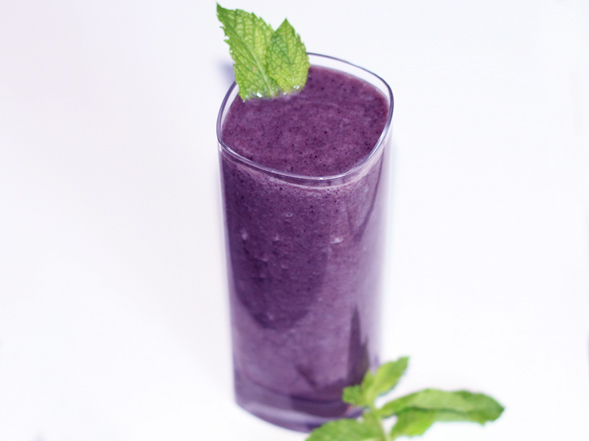
Other Ingredient Options:
1 scoop protein powder blend (if you opt to use a protein powder blend, you can eliminate either the almonds or almond butter or both if you like)
1 tablespoon “greens” powder (if you opt to use fresh berries, cut milk amount by approximately ¼ cup and add 3-4 ice cubes)
Directions:
Place frozen berries in blender. Add rest of ingredients except for coconut oil. Blend thoroughly until well-combined. Add melted coconut oil and quickly blend again before it hardens. Makes 1 serving.
Copyright © 2008-2015 Lucinda Bedogne, CNHP, CNC
Post Your Comment...
|
|
||||||||||||


